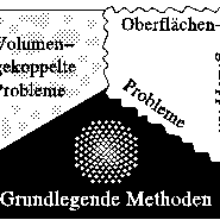- Description
-
Computer simulations of processes in the subsurface are based uponmathematical models for multiphase flow in porous media. They treatthe concurrent movement of more than one fluid phase in a solidskeleton (e.g. flow of water, oil, air in soil) and are subject topermanent further development (e.g. Helmig R., 1997 [1]). In manycases, these fluids are miscible and the models therefore also have toconsider the multiple components within the phases. Often, phasechange by evaporation/condensation takes place which is additionallycoupled with an exchange of energy. The special relevance of thesecomplex simulations lies in the fact that, in different fields oftechnical applications, they are the only practible forecastinginstrument because the high costs or the long-term time frame ofexperiments make the latter infeasible.
Current challenges in environmental engineering comprise problemslike, for instance, the long-term storage of the greenhouse gasCO2 by injection into the subsurface to stop global warmingor the remediation of contaminated sites. To tackle these problems,today's engineers need reliable, fast and robust simulationalgorithms. The current work uses the program system MUFTE-UG(developed in cooperation with the former SFB 404 project C4) as itsbasis (Helmig R. et al., 1998 [2]). It is designed as aresearch code to combine the modelling of the relevant physicalprocesses with the application of new discretisation techniques andsolution methods including, for example, multigrid and parallelisationstrategies.
Focal Point I: Multigrid Solver and Boundary Conditions
As an example of the increasingly complex physics described by themultiphase multicomponent models, the ongoing research of the workinggroup into the sequestration of CO2 can be taken (figure 1, PruessK. et al., 2002 [3]).
Figure 1: Simulation of injection of CO2 into a geological formationand its spread
A numerical algorithm was implemented in the simulator MUFTE-UG whichtakes into account the appearance and disappearance of phases, i.e.the number and combination of the locally existing fluid phasestogether with the mathematical equations describing them may change.The model yields large nonlinear systems of equations which needmultigrid preconditioners for a fast solution. But then the problemarises that a change of primary variables is possible. So thecoarse-grid corrections, which are calculated for the primaryvariables on the coarse-grid nodes and then interpolated on the finegrid, may disagree with the expected values for the primary variableson the finer grid, which sometimes leads to numerical problems.
A possible way out of this situation lies in the implantation ofknowledge about the processes that are occurring into the transferoperators of the multigrid algorithm. This is in some wayunconventional as that part of the mathematical procedure classicallyknows nothing about "what's going on in the physics". However, it willbring more robustness into the solution procedure and speed things up.As an effect, more practical problems will become "simulatable"without numerical difficulties.
Another approach to ease exact mathematical modelling and therebyfacilitate more realistic simulations of practical questions is toallow boundary conditions to secondary variables. This procedure willfurther push back the frontier of problems that can be addressed byMUFTE-UG in a physically correct way.
Focal Point II: Upscaling and Heterogeneities
The term upscaling denotes the transition from a finer to a coarserscale where the underlying model is probably adjusted to the newscale. This is done by sieving important from unimportant information.To design better upscaling sieves, a better acquisition of theessential and characteristic properties of the physical processes inheterogeneous systems is necessary. Techniques for this are alreadypresent (figure 2, Braun C. et al., 2002 [4]) and will be furtherdeveloped in the ongoing project period.
Figure 2: Upscaling Toolbox
The gain in knowledge of the characteristics of the upscaled systemproperties leads directly to more advanced models. One new insight,for example, is the fact that, for a heterogeneous set-up, therelative permeability on the coarser scale generally showsdirection-dependent properties and therefore has to be described by ananisotropic tensor (figure 3).
Figure 3: Upscaling example. Top left: heterogeneous set-up. Bottomleft: anisotropic behaviour of upscaled relative permeability. Topright: upscaled flow with isotropic properties. Bottom right: upscaledflow with anisotropic properties
Consequently, this new knowledge has to be incorporated into a moresophisticated model. First results simulated on a Cartesian grid for arelative permeability tensor with main directions parallel to the gridlines can be found in Eichel H., 2004 [5]. At the moment, the presentapproach is being extended to be capable of coping with generaltensors on unstructured grids, taking into account the need forupwinding schemes in advection-dominated scenarios.
At the same time, the alternative and more powerful instrument ofmultipoint flux approximations (MPFA, Aavatsmark I., 2002 [6]) isinvestigated. This is a whole class of numerical fluxes that isapplicable to general unstructured grids and promises a greatimprovement compared to the conventional discretised fluxes as itreduces the influence of grid effects. This will result inqualitatively better predictions of the numerical simulation, but onehas to pay a higher price in terms of simulation time.
References
- Helmig R., Multiphase Flow and Transport Processes in thesubsurface - A contribution to the Modeling of Hydrosystems, SpringerVerlag, 1997.
- Helmig R., Class H., Huber R., Sheta H., Ewing J., Hinkelmann R.,Jakobs H., Bastian P., Architecture of the Modular Program SystemMUFTE_UG for Simulating Multiphase Flow and Transport Processes inHeterogeneous Porous Media, Mathematische Geologie 2 (1998).
- Pruess K., Bielinski A., Ennis-King J., Fabriol R., Le Gallo Y.,Garcia J., Jessen K., Kovscek T., Law D.H.-S., Oldenburg C., Pawar R.,Rutqvist J., Steefel C., Travis B., Tsang C.-F., White S., Xu Tianfu,Code Comparison Builds Confidence in Numerical Models for GeologicDisposal of CO2. Sixth International Conference on Greenhouse GasControl Technologies, Kioto, Japan, Oktober 2002.
- Braun C., Helmig R., Manthey S., Determination of constitutiverelationships for two-phase flow processes in heterogeneous porousmedia with emphasis on the relativepermeability-saturation-relationship, Accepted for Publication inJournal of Contaminant Hydrology (2002).
- Eichel H., Helmig R., Neuweiler I., Cirpka O., Upscaling ofTwo-Phase Flow Processes in Porous Media, Submitted to Transport inPorous Media (2003).
- Aavatsmark I., An Introduction to Multipoint Flux Approximationsfor Quadrilateral Grids, Computational Geosciences 6 (2002), 405-432.
- Project manager
-
Helmig, Rainer
- Deputy
- Research assistant
-
Niessner, Jennifer
- Department
-
LH2
- Duration
-
01/2004 - 12/2006
- Funding
-
Collaborative Research Center / German Research Foundation (DFG)
Contact






